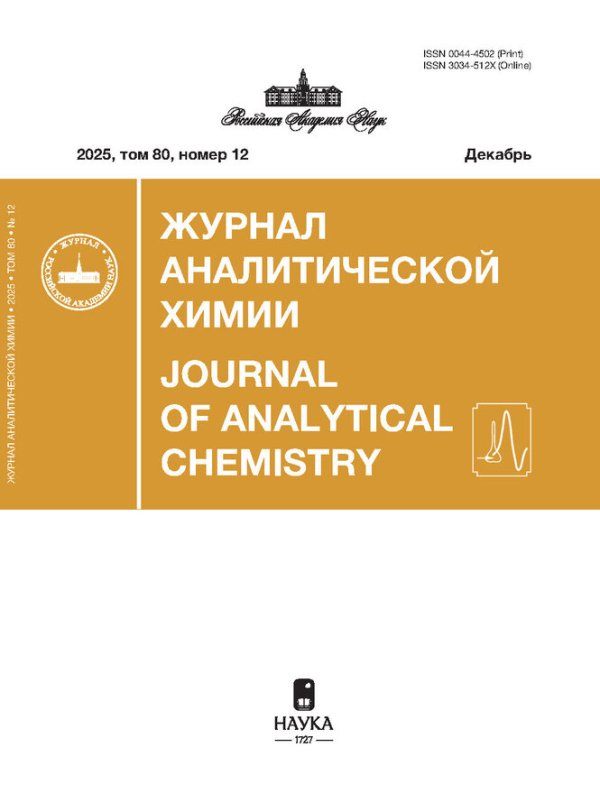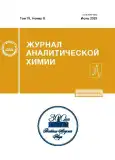Resins Based on Polystyrene–Divinylbenzene with Attached Hydrophilized Polyethyleneimine for Ion and Hydrophilic Interaction Liquid Chromatography
- Authors: Gorbovskaya A.V.1, Popkova E.K.1, Uzhel’ A.S.1, Shpigun O.A.1, Zatirakha A.V.1
-
Affiliations:
- Department of Chemistry, Lomonosov Moscow State University
- Issue: Vol 78, No 6 (2023)
- Pages: 507-519
- Section: ORIGINAL ARTICLES
- Submitted: 14.10.2023
- URL: https://journals.rcsi.science/0044-4502/article/view/136031
- DOI: https://doi.org/10.31857/S0044450223060063
- EDN: https://elibrary.ru/DWPMLR
- ID: 136031
Cite item
Full Text
Abstract
To expand the field of application of anion exchangers based on a copolymer of styrene and divinylbenzene with attached polyethyleneimine, quaternized with glycidol, the following conditions for their synthesis were varied: the amount of the added glycidol, temperature, and duration of synthesis. The influence of these factors on the capacity, selectivity, and efficiency of the resins in the mode of suppressed ion chromatography was studied; in addition, the stationary phases were studied in the mode of hydrophilic interaction liquid chromatography using the Tanaka test. It was shown that the synthesis conditions under study ensure the control of the capacity and selectivity of anion exchangers, while their hydrophilicity changes insignificantly. The behavior of oxoanions on covalently attached resins in the ion chromatography mode was studied for the first time, and the applicability of phases with quaternized polyethyleneimine in the hydrophilic interaction liquid chromatography mode to the separation of sugars, amino acids, water-soluble vitamins, nucleosides, and nitrogenous bases was demonstrated for the first time.
About the authors
A. V. Gorbovskaya
Department of Chemistry, Lomonosov Moscow State University
Email: anna_uzhel@mail.ru
Moscow, Russia
E. K. Popkova
Department of Chemistry, Lomonosov Moscow State University
Email: anna_uzhel@mail.ru
Moscow, Russia
A. S. Uzhel’
Department of Chemistry, Lomonosov Moscow State University
Email: anna_uzhel@mail.ru
Moscow, Russia
O. A. Shpigun
Department of Chemistry, Lomonosov Moscow State University
Email: anna_uzhel@mail.ru
Moscow, Russia
A. V. Zatirakha
Department of Chemistry, Lomonosov Moscow State University
Author for correspondence.
Email: anna_uzhel@mail.ru
Moscow, Russia
References
- Weiss J. Handbook of Ion Chromatography. Weinheim: WILEY-VCH Verlag GmbH & Co. KGaA, 2016. 1576 p. https://doi.org/10.1002/9783527651610
- Zatirakha A.V., Smolenkov A.D., Shpigun O.A. Preparation and chromatographic performance of polymer-based anion exchangers for ion chromatography: A review // Anal. Chim. Acta. 2016. V. 904. P. 33. https://doi.org/10.1016/j.aca.2015.11.012
- Pohl C. Stationary phases and suppressors in ion chromatography, 1975–2000 / Ion Chromatography: Instrumentation, Techniques and Applications. Academic Press, 2021. Ch. 2. P. 15. https://doi.org/https://doi.org/10.1016/B978-0-12-813075-9.00005-4
- Pohl C. Stationary phases in ion chromatography / Ion Chromatography: Instrumentation, Techniques and Applications. Academic Press, 2021. Ch. 3. P. 43. https://doi.org/https://doi.org/10.1016/B978-0-12-813075-9.00006-6
- Liu X., Wang Y., Cong H., Shen Y., Yu B. A review of the design of packing materials for ion chromatography // J. Chromatogr. A. 2021. V. 1653. Article 462313. https://doi.org/10.1016/j.chroma.2021.462313
- Uzhel A.S., Borodina A.N., Gorbovskaya A.V., Shpigun O.A., Zatirakha A.V. Determination of full organic acid profiles in fruit juices and alcoholic beverages using novel chemically derivatized hyperbranched anion exchanger // J. Food Compos. Anal. 2021. V. 95. Article 103674. https://doi.org/10.1016/j.jfca.2020.103674
- Uzhel A.S., Zatirakha A.V., Smolenkov A.D., Shpigun O.A. Quantification of inorganic anions and organic acids in apple and orange juices using novel covalently-bonded hyperbranched anion exchanger with improved selectivity // J. Chromatogr. A. 2018. V. 1567. P. 130. https://doi.org/10.1016/j.chroma.2018.06.065
- Liu J., Wang Y., Cheng H., Wang N., Wu S., Zhang P., Zhu Y. High-capacity anion exchangers based on poly (glycidylmethacrylate-divinylbenzene) microspheres for ion chromatography // Talanta. 2016. V. 159. P. 272. https://doi.org/10.1016/j.talanta.2016.06.034
- Zatirakha A.V., Smolenkov A.D., Pirogov A.V., Nesterenko P.N., Shpigun O.A. Preparation and characterisation of anion exchangers with dihydroxy-containing alkyl substitutes in the quaternary ammonium functional groups // J. Chromatogr. A. 2014. V. 1323. P. 104. https://doi.org/10.1016/j.chroma.2013.11.013
- Shchukina O.I., Zatirakha A.V., Smolenkov A.D., Nesterenko P.N., Shpigun O.A. Anion exchangers with branched functional ion exchange layers of different hydrophilicity for ion chromatography // J. Chromatogr. A. 2015. V. 1408. P. 78. https://doi.org/10.1016/j.chroma.2015.06.039
- Щукина О.И., Затираха А.В., Смоленков А.Д., Шпигун О.А. Использование эпихлоргидрина для одновременного повышения гидрофильности и пространственного удаления функциональных групп анионообменников для ионной хроматографии // Вестн. Моск. ун-та. Сер. 2. Химия. 2014. Т. 55. С. 219. (Shchukina O.I., Zatirakha A.V., Smolenkov A.D., Shpigun O.A. Using of epichlorohydrin for simultaneous increase of functional groups hydrophilicity and their spatial moving away from the matrix of anion exchangers for ion chromatography // Moscow Univ. Chem. Bull. 2014. V. 69. P. 168.)
- Затираха А.В., Смоленков А.Д., Шпигун О.А. Синтез новых полимерных анионообменников с использованием реакции нитрования // Сорбционные и хроматографические процессы. 2011. Т. 11. С. 473.
- Shchukina O.I., Zatirakha A.V., Smolenkov A.D., Nesterenko P.N., Shpigun O.A. Novel anion exchangers with spatially distant trimethylammonium groups in linear and branched hydrophilic functional layers // Chromatographia. 2015. V. 78. P. 147. https://doi.org/10.1007/s10337-014-2831-5
- Uzhel A.S., Zatirakha A.V., Shchukina O.I., Smolenkov A.D., Shpigun O.A. Covalently-bonded hyperbranched poly(styrene-divinylbenzene)-based anion exchangers for ion chromatography // J. Chromatogr. A. 2016. V. 1470. P. 97. https://doi.org/10.1016/j.chroma.2016.10.009
- Uzhel A.S., Zatirakha A.V., Smirnov K.N., Smolenkov A.D., Shpigun O.A. Anion exchangers with negatively charged functionalities in hyperbranched ion-exchange layers for ion chromatography // J. Chromatogr. A. 2017. V. 1482. P. 57. https://doi.org/10.1016/j.chroma.2016.12.066
- Zhang K., Lou C., Zhu Y., Zhi M., Zeng X., Shou D. Covalently grafted anion exchangers with linear epoxy-amine functionalities for high-performance ion chromatography // Talanta. 2019. V. 194. P. 485. https://doi.org/10.1016/j.talanta.2018.10.062
- Shchukina O.I., Zatirakha A.V., Uzhel A.S., Smolenkov A.D., Shpigun O.A. Novel polymer-based anion-exchangers with covalently-bonded functional layers of quaternized polyethyleneimine for ion chromatography // Anal. Chim. Acta. 2017. V. 964. P. 187. https://doi.org/10.1016/j.aca.2017.01.062
- Yang Z., Li Z., Zhang F., Yang B., Zhang S. A novel hydrophilic polymer-based anion exchanger grafted by quaternized polyethyleneimine for ion chromatography // Talanta. 2019. V. 197. P. 199. https://doi.org/10.1016/j.talanta.2019.01.024
- Wilms D., Stiriba S.-E., Frey H. Hyperbranched polyglycerols: From the controlled synthesis of biocompatible polyether polyols to multipurpose applications // Acc. Chem. Res. 2010. V. 43. P. 129. https://doi.org/10.1021/ar900158p
- Ardila-Suárez C., Rojas-Avellaneda D., Ramirez-Caballero G.E. Effect of temperature and catalyst concentration on polyglycerol during synthesis // Int. J. Polym. Sci. 2015. P. 1. https://doi.org/10.1155/2015/910249
- Geng H., Jing J., Zhang F.F., Zhang, F., Yang, B. (2020). A polar stationary phase obtained by surface-initiated polymerization of hyperbranched polyglycerol onto silica // Talanta. V. 209. Article 120525. https://doi.org/10.1016/j.talanta.2019.120525
- Li H., Zhang X., Zhang L., Cang H., Kong F., Fan D., Wang W. Hyperbranched polyglycerol functionalized silica stationary phase for hydrophilic interaction liquid chromatography // Anal. Sci. 2018. V. 34. P. 433. https://doi.org/10.2116/analsci.17P486
- Geng H., Wang Z., Zhang F.F., Li Z., Yang B. A hyperbranched polyglycerol-functionalized polymer polar stationary phase // J. Chromatogr. A. 2022. V. 1670. Article 462946. https://doi.org/10.1016/j.chroma.2022.462946
- Pohl C.A. Novel method for manipulation of anion-exchange selectivity by derivatizing hydroxyl groups in the proximity of quaternary nitrogen ion-exchange sites with glycidol // Talanta. 2018. V. 177. P. 18. https://doi.org/10.1016/j.talanta.2017.09.042
- Popov A.S., Spiridonov K.A., Uzhel A.S., Smolenkov A.D., Chernobrovkina A.V., Zatirakha, A.V. Prospects of using hyperbranched stationary phase based on poly(styrene-divinylbenzene) in mixed-mode chromatography // J. Chromatogr. A. 2021. V. 1642. Article 462010. https://doi.org/10.1016/j.chroma.2021.462010
- Uzhel A.S., Gorbovskaya A.V., Zatirakha A.V., Smolenkov A.D., Shpigun O.A. Manipulating selectivity of covalently-bonded hyperbranched anion exchangers toward organic acids. Part II: Effect of mono- and dicarboxylic amino acids in the internal part of the functional layer // J. Chromatogr. A. 2019. V. 1596. P. 117. https://doi.org/10.1016/j.chroma.2019.03.006
- Uzhel A.S., Gorbovskaya A.V., Zatirakha A.V., Smolenkov A.D., Shpigun O.A. Manipulating selectivity of covalently-bonded hyperbranched anion exchangers toward organic acids. Part I: Influence of primary amine substituents in the internal part of the functional layer // J. Chromatogr. A. 2019. V. 1589. P. 65. https://doi.org/10.1016/j.chroma.2018.12.052
- Uzhel A.S., Zatirakha A.V., Smolenkov A.D., Shpigun O.A. Manipulating selectivity of covalently-bonded hyperbranched anion exchangers toward organic acids. Part III: Effect of diamine structure in the external part of the functional layer // J. Chromatogr. A. 2019. V. 1602. P. 310. https://doi.org/10.1016/j.chroma.2019.05.052
- Uzhel A.S., Gorbovskaya A.V., Zatirakha A.V., Smolenkov A.D., Shpigun O.A. Manipulating selectivity of covalently-bonded hyperbranched anion exchangers toward organic acids. Part IV: General algorithm based on the variation of external part of the functional layer // J. Chromatogr. A. 2020. V. 1634. Article 461648. https://doi.org/10.1016/j.chroma.2020.461648
- Kawachi Y., Ikegami T., Takubo H., Ikegami Y., Miyamoto M., Tanaka N. Chromatographic characterization of hydrophilic interaction liquid chromatography stationary phases: Hydrophilicity, charge effects, structural selectivity, and separation efficiency // J. Chroma-togr. A. 2011. V. 1218. P. 5903. https://doi.org/10.1016/j.chroma.2011.06.048
- Chen J., Peng H., Zhang Z., Zhang Z., Ni R., Chen Y., Chen P., Peng J. Facile fabrication of silica@covalent organic polymers core-shell composites as the mixed-mode stationary phase for hydrophilic interaction/reversed-phase/ion-exchange chromatography // Talanta. 2021. V. 233. Article 122524. https://doi.org/10.1016/j.talanta.2021.122524
- Liang C., Lucy C.A. Characterization of ion chromatography columns based on hydrophobicity and hydroxide eluent strength // J. Chromatogr. A. 2010. V. 1217. P. 8154. https://doi.org/10.1016/j.chroma.2010.10.065
- Nesterenko P.N., Nesterenko E.P. Hydrophobicity of polymer based anion-exchange columns for ion chromatography // Heliyon. 2021. V. 7. Article e07290. https://doi.org/10.1016/j.heliyon.2021.e07290
- Pohl C., Saini C. New developments in the preparation of anion exchange media based on hyperbranched condensation polymers // J. Chromatogr. A. 2008. V. 1213. P. 37. https://doi.org/10.1016/j.chroma.2008.10.072
- Pohl C.A., Stillian J.R., Jackson P.E. Factors controlling ion-exchange selectivity in suppressed ion chromatography // J. Chromatogr. A. 1997. V. 789. P. 29. https://doi.org/10.1016/S0021-9673(97)00705-X
- Pohl C.A., Srinivasan K. Electrostatically attached highly branched anion-exchange phases derived from diamines and diepoxides // Talanta. 2018. V. 184. P. 338. https://doi.org/10.1016/j.talanta.2018.02.106
- Коваленко И.В. Влияние структуры спейсера и цвиттер-иона на свойства новых цвиттер-ионных сорбентов для гидрофильной хроматографии / Материалы международной научной конференции студентов, аспирантов и молодых ученых “Ломоносов-2021”, секция “Химия”. Москва. МГУ им. М.В. Ломоносова. 12–23 апреля, 2021. С. 42.
- Чикурова Н.Ю., Шемякина А.О., Брыскина Д.Э., Нуриев В.Н., Комаров А.А., Статкус М.А., Ставрианиди А.Н., Чернобровкина А.В. Новый сорбент для гидрофильной хроматографии на основе силикагеля, модифицированного по реакции Уги // Журн. аналит. химии. 2021. Т. 76. С. 832. https://doi.org/10.31857/s0044450221090036 (Chikurova N.Yu., Shemyakina A.O., Bryskina D.E., Nuriev V.N., Komarov A.A., Statkus M.A., Stavrianidi A.N., Chernobrovkina A.V. A Novel adsorbent for hydrophilic chromatography based on silica modified by the Ugi reaction // J. Anal. Chem. 2021. V. 76. P. 1083.)
- Fan F., Wang L., Li Y., Wang X., Lu X., Guo Y. A novel process for the preparation of Cys-Si-NIPAM as a stationary phase of hydrophilic interaction liquid chromatography (HILIC) // Talanta. 2020. V. 218. Article 121154. https://doi.org/10.1016/j.talanta.2020.121154
- Chikurova N.Yu., Shemiakina A.O., Shpigun O.A., Chernobrovkina A.V. Multicomponent Ugi reaction as a tool for fast and easy preparation of stationary phases for hydrophilic interaction liquid chromatography. Part I: The influence of attachment and spacing of the functional ligand obtained via the Ugi reaction // J. Chromatogr. A. 2022. V. 1666. Article 462804. https://doi.org/10.1016/j.chroma.2022.462804
Supplementary files














